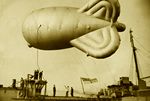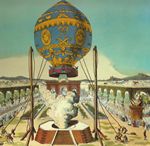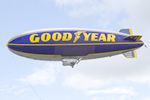A Select Vocabulary of Airship Terms:

Aerostat:
A general term for all lighter-than-air craft (powered or not, dirigible or not)
The simplest can be a sealed black plastic bag that floats after being heated by sunlight.
The term also includes the most complex Zeppelin, but not a craft whose flight depends on mechanical lift such as a wing or propeller.

Airship:
A general term for powered, lighter-than-air vessels.
While an Airplane (Aeroplane) gets its lift from air moving over the wings at speed, an Airship gets its lift from an envelope filled with a lower-density gas, in relation to the surrounding atmosphere, causing the vessel to "float." Thus an airplane always needs to be moving to stay aloft, while an airship can simply float while otherwise standing still..
Ballonet
A bladder (air bag) inside the envelope of an aerostat, especially in blimps. They are used to maintain the shape and assist with trim and weight distribution by means of air valves and blowers, which allow the pilot to exhaust and add gas (air) when needed. In a non-rigid airship it is important to maintain the shape of the envelope, which is achieved with internal gas pressure. As the vessel changes altitude, the surrounding atmospheric pressure changes, requiring the vessel to adjust its internal pressure. To reduce internal pressure without a ballonet, it would be necessary to vent the precious lifting gas, which would need to be replaced later as the vessel descends. As the air filling the ballonet is denser (heavier) than the lifting gas, trim of the vessel can be regulated by adjusting the gas volume of ballonets fore and aft, moving the balance of lifting gas to level (trim) the vessel.

Balloon:
An Aerostat with a non-rigid gas envelope, and no specific steering or propulsion method. Typically the gas envelope is filled with hot-air, and the Balloon is equipped with some means of heating and venting the hot air. Ballons can also be filled with other lifting gasses such as hydrogen, helium and ammonia. Typically they also carry extra weight which can be dropped to provide lift quickly. Balloons can either be used with a long tether, to take-off and land at the same spot, or may be flown un-tethered in which case the prevailing winds determine the direction and speed of travel.
- The first human flight was in a balloon built by the Montgolfier Brothers in 1783.
Bladder:
Another, more generic term for a ballonet. An air-filled sac with variable volume.

Blimp (Non-Rigid Airship):
The most produced, and still in use form of airship - a powered, dirigible (steerable) Aerostat.
Consisting primarily of a gas envelope (almost always Helium filled), from which a "gondola" is suspended, along with some forms of steering and propulsion (rudders and propellers.) A blimp holds its shape by the construction of the envelop and the pressure of the gas inside the envelope (just like a party balloon) this leaves the envelope more susceptible to wind and different atmospheric pressures distorting its shape. Which also limits blimps to smaller sizes than Zeppelins. (Zeppelins, by contrast have a rigid structure which contains multiple gas envelopes, and are less susceptible to deformation.)
- The US Navy Blimp program during WWII had a 100% success rate protecting hundreds of Ships in supply convoys against U-Boat attacks.
Blau-Gas:

Dirigible:
"Capable of being steered, guided, or directed." (French: dirigeable – "directable")
Usually refers to a steerable aerostat, in otherwords an airship: Blimp or Zeppelin.
- The first powered and steerable airship to fly was built by Henri Giffard in France in 1852.

Duralumin:
A trade name for one of the earliest types of age-hardenable aluminium alloys.
Its first use in aerostatic airframes was in rigid airship frames eventually including all those of the "Great Airship" era of the 1920s and 1930s: the British built R-100, the German passenger Zeppelins LZ 127 Graf Zeppelin, LZ 129 Hindenburg, LZ 130 Graf Zeppelin II, and U.S. Navy airships USS Los Angeles (ZR-3, ex-LZ 126), USS Akron (ZRS-4) and USS Macon (ZRS-5).
Elevator:
Envelope:
In an aerostat, the major structure which contains the lifting gas. For a hot-air balloon or a blimp, it is in fact, the "balloon" part. Blimps need internal ballonets (gas bladders) to adjust for gas density changes to maintain the shape of the envelope. For a zeppelin, the envelope has an internal structure to maintain its shape, which then contains multiple gas cells within that frame. The envelope us made of more durable material than the gas cells. For most early airships, hydrogen-cells were made from cow intestines (actually the lining of the appendix) and early Zeppelins used about a quarter of a million cows each. In World War I, the Germans had to give up sausages in order to provide for the Military Zeppelins. Later the US discovered a process of treating cotton cloth with gelatin to make a gas-impermeable cloth. The same material was used on the Hindenburg (LZ-129) and her sister the Graf Zeppelin 2 (LZ-130) .
National Geo.: Cows & Zeppelins
Gas-Cell:
A gas impermeable sac wich can be filled with lifting gas such as hydrogen or helium. Rigid airships usually have several gas cell within the envelope. When using hydrogen it was common to fill and vent the cell as needed to maintain the proper lifting volume, as well as to level or "trim"the vessel. With much more expensive helium additional equipment was needed to manage lift without venting the helium. In some later Zeppelins, rather than carry as much liquid fuel, a gas-cell might be filled with an almost neutral buoyancy fuel-gas called "Blau-Gas". This took up space, but reduced the gross weight of the ship.
Hybrid Airship:
Lifting-Gas:
Mooring-Mast:
Non-Rigid Airship (Blimp):
Rigid Airship:
Rudder:
Useful Lift:
Zeppelin:
See Also:
SKYSHIPS.org

